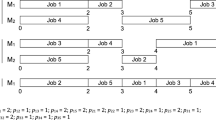Abstract
This paper deals with the open shop scheduling problem (OSP) with makespan minimization. An exact dynamic programming algorithm is proposed for solving the OSP to optimality. This approach is applied to the OSP for the first time. Computational results show that the proposed algorithm is able to solve moderate benchmark instances.



Similar content being viewed by others
References
Blum C (2005) Beam-acohybridizing ant colony optimization with beam search: an application to open shop scheduling. Comput Oper Res 32(6):1565–1591
Brucker P, Hurink J, Jurisch B, Wöstmann B (1997) A branch and bound algorithm for the open-shop problem. Discrete Appl Math 76(1–3):43–59
Colak S, Agarwal A (2005) Non-greedy heuristics and augmented neural networks for the open-shop scheduling problem. Nav Res Logist 52(7):631–644
Dorndorf U, Pesch E, Phan-Huy T (2001) Solving the open shop scheduling problem. J Sched 4(3):157–174
Gonzalez T, Sahni S (1976) Open shop scheduling to minimize finish time. J ACM 23(4):665–679
Grimes D, Hebrard E, Malapert A (2009) Closing the open shop: contradicting conventional wisdom. In: Principles and Practice of Constraint Programming-CP, vol 2009, pp 400–408
Gromicho J, Van Hoorn J, Saldanha-da Gama F, Timmer G (2012) Solving the job-shop scheduling problem optimally by dynamic programming. Comput Oper Res 39(12):2968–2977
Guéret C, Prins C (1999) Forbidden intervals for open-shop problems. In: IFORS’99
Guéret C, Jussien N, Prins C (2000) Using intelligent backtracking to improve branch-and-bound methods: an application to open-shop problems. Eur J Oper Res 127(2):344–354
Harmanani HM, Ghosn SB (2016) An efficient method for the open-shop scheduling problem using simulated annealing. In: Information technology: New generations, Springer, pp 1183–1193
Malapert A, Cambazard H, Guéret C, Jussien N, Langevin A, Rousseau LM (2012) An optimal constraint programming approach to the open-shop problem. INFORMS J Comput 24(2):228–244
Ozolins A (2018) Bounded dynamic programming algorithm for the job shop problem with sequence dependent setup times. Oper Res pp 1–28
Ozolins A (2019) Improved bounded dynamic programming algorithm for solving the blocking flow shop problem. Central Eur J Oper Res 27(1):15–38
Pongchairerks P, Kachitvichyanukul V (2016) A two-level particle swarm optimisation algorithm for open-shop scheduling problem. Int J Comput Sci Math 7(6):575–585
Prins C (2000) Competitive genetic algorithms for the open-shop scheduling problem. Math Methods Oper Res 52(3):389–411
Sha D, Hsu CY (2008) A new particle swarm optimization for the open shop scheduling problem. Comput Oper Res 35(10):3243–3261
Taillard E (1993) Benchmarks for basic scheduling problems. Eur J Oper Res 64(2):278–285
Tamura N, Taga A, Kitagawa S, Banbara M (2009) Compiling finite linear CSP into SAT. Constraints 14(2):254–272
Author information
Authors and Affiliations
Corresponding author
Additional information
Publisher's Note
Springer Nature remains neutral with regard to jurisdictional claims in published maps and institutional affiliations.
Appendix
Appendix
We study an example, which explains how to create forbidden intervals. Similarly as by Guéret and Prins (1999), we investigate benchmark instance j3-per0-1, see Table 7. Also, we set \(bound=1174\).
The algorithm selects operation \(O_{2,2}\), which has the longest processing time \(p^*=511\). Due to a symmetry, \(O_{2,2}\) cannot start later than
Thus, the forbidden interval of operation \(O_{2,2}\) is [332, 1174).
Due to the symmetry, operations \(O_{1,2},O_{2,1},O_{2,3},O_{3,2}\) cannot be completed in the interval \([332,p^*)\). Thus, we have For example, if \(O_{1,2}\) started at 23, then this operation would be completed at 332, which belongs to the forbidden interval.
Operations | Forbidden intervals due to a symmetry |
|---|---|
\(O_{1,2}\) | [23, 511) |
\(O_{2,1}\) | [232, 511) |
\(O_{2,2}\) | [332, 1174) |
\(O_{2,3}\) | [0, 511) |
\(O_{3,2}\) | [152, 511) |
The subset-sum values are:
Name | Subset-sums | |||||||
|---|---|---|---|---|---|---|---|---|
\(S_{M_1}\) | 0 | 100 | 436 | 464 | 536 | 564 | 900 | 1000 |
\(S_{M_2}\) | 0 | 180 | 309 | 489 | 511 | 691 | 820 | 1000 |
\(S_{M_3}\) | 0 | 227 | 384 | 389 | 611 | 616 | 773 | 1000 |
\(S_{J_1}\) | 0 | 227 | 309 | 464 | 536 | 691 | 773 | 1000 |
\(S_{J_2}\) | 0 | 100 | 389 | 489 | 511 | 611 | 900 | 1000 |
\(S_{J_3}\) | 0 | 180 | 384 | 436 | 564 | 616 | 820 | 1000 |
Subset-sum values in bold can be removed due to a symmetry.
Using algorithm proposed by Guéret and Prins (1999), we obtain forbidden intervals for both the starting and completion times. These intervals have directly been derived from the subset-sum values.
By joining all previously obtained forbidden intervals, we obtain the resulting forbidden intervals for the starting times of operations.
For example, the forbidden intervals are obtained for the starting time of operation \(O_{3,2}\) in the following way. The interval [152, 511) is forbidden due to a symmetry. From Table 8 it follows that
and
are also the forbidden intervals.
Since \(p_{3,2}=180\) and Table 8 also represents the forbidden intervals for the completion times, we have that intervals
and
are forbidden.
Finally, since operation \(O_{3,2}\) has to be completed before \(bound=1174\), we have that [994, 1174) is also forbidden. Thus, we have obtained the full forbidden intervals for operation \(O_{3,2}\), see Table 9.
See Table 10.
Rights and permissions
About this article
Cite this article
Ozolins, A. Dynamic programming approach for solving the open shop problem. Cent Eur J Oper Res 29, 291–306 (2021). https://doi.org/10.1007/s10100-019-00630-3
Published:
Issue Date:
DOI: https://doi.org/10.1007/s10100-019-00630-3




